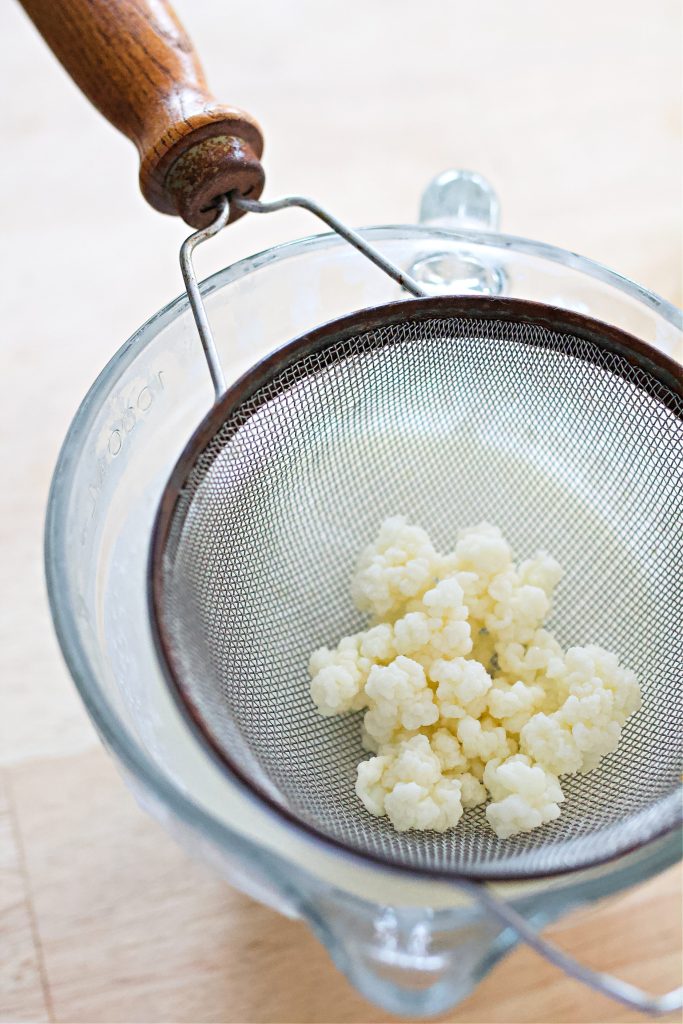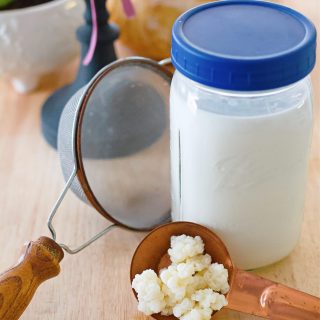How To Make Homemade Milk Kefir And How To Use It
Ever tried making homemade milk kefir? It’s this fantastic, thick, and tangy probiotic-rich fermented drink packed with gut-friendly probiotics and good bacteria. The health benefits of kefir are immense, and I’ve got some tips that make the whole process a breeze. Let’s explore what exactly milk kefir grains are, how to use them, storage tips, and more.

Understanding the Basics: What is Kefir & A Quick History
I like to do a deep dive when attempting to bring anything new into our homestead. Never wanting to jump on a trend based on “because others in the health arena are doing it.” However, fermented foods like kefir always catch my attention. When I first heard about milk kefir, I was intrigued.
Kefir is considered good for several reasons:
This is primarily due to its unique composition and fermentation process. Here are some key reasons why kefir is often considered a beneficial addition to a healthy diet.
Probiotic Benefits: Kefir is rich in probiotics, which support gut health by balancing the microbiome, aiding digestion, and boosting the immune system.
Improved Digestion: The probiotics in kefir help balance gut flora, aiding in digestion and absorption of nutrients. This is especially helpful for individuals with lactose intolerance.
Nutrient Content: Kefir provides essential vitamins and minerals like B vitamins, calcium, magnesium, and vitamin K2.
Complete Protein: Kefir made from cow’s milk or non-dairy milk is a good source of complete protein. It contains all essential amino acids needed for our body’s functions.
Potential Immune Support: The probiotics in milk kefir may enhance the immune system, contributing to a defense against infections.
Anti-Inflammatory Properties: Some studies suggest kefir has anti-inflammatory properties.
Mood and Mental Health: Research on the gut-brain connection shows that probiotics in kefir can impact mental health and mood.
Easy Digestibility: The fermentation process makes milk kefir more digestible by breaking down lactose and proteins.
Can I Make Kefir Grains Myself?
My first question after understanding the basics was: Can I make kefir grains myself?
The answer: No.
Kefir grains are living organisms that must come from other grains and then can grow and multiply. If you’re starting out, it’s best to source live kefir grains from a reliable place. Affiliate links to the grains I purchased are included below.
What Are Kefir Grains?
Kefir grains have a unique, gelatinous texture resembling little pieces of cauliflower. These grains are clusters of bacteria and yeast that feed on the lactose in cow’s milk or non-dairy milk, transforming it into creamy kefir. The kefir culture produces carbon dioxide and lactic acid, which result in a tangy, slightly fizzy milk drink.
How Does Kefir Work?
Kefir grains thrive on lactose in milk, converting it into a nutrient-rich drink. The fermentation process is straightforward and one of the easiest ferments you can do at home. Whether you use cow’s milk, coconut milk, or non-dairy milk, your kefir grains will still create kefir.
Where to Get Your Kefir Grains?
If you have a friend making kefir, ask them to share some extra grains. Kefir grains grow quickly, and most fermenting fanatics are happy to share. If not, you can order live kefir grains from Amazon (see affiliate links below).
The exact grains I purchased (I ordered mine may 23′ and they’re still going strong!)
Another great option off Amazon
To get started, all you need is a glass quart jar, a plastic spin top lid, a plastic strainer, and some milk.

How to Start the Grains
Let’s walk through caring for your kefir grains and making your first batch of milk kefir.
Day 1: Activating Kefir Grains
Place your live kefir grains in a glass jar and add one cup of organic milk, cow’s milk, or coconut milk. Cover the jar with a coffee filter or cloth and secure with a rubber band.
Day 2: Fermentation Process Begins
Leave the mixture at room temperature (68-85°F) for 24 hours. Direct sunlight can affect fermentation, so keep the jar in a cool, shaded spot.
Day 3: First Strain
After 24 hours, strain the kefir grains using a plastic strainer. This liquid is your first batch of kefir, though it might not be tangy enough yet. You can give it to your chickens or use it as fertilizer.
Day 4: Second Fermentation
Pour the strained liquid into a clean jar and cover loosely with a plastic lid. Let it ferment for another 12-48 hours. This second ferment enhances the flavor and consistency of your creamy kefir.
Day 5: Final Strain and Refrigeration
Strain the kefir again to remove any fresh grains. Now, you have a delicious batch of homemade kefir! Add more cups of milk to the grains to start your next batch.
Tips for Best Results
Regular Basis: Kefir grains thrive with routine. Keeping a regular fermentation schedule helps produce the best results.
Quality Milk: Whether you use organic milk, raw milk, or ultra-pasteurized milk, the quality of the type of milk affects the outcome of your kefir. Raw milk provides rich nutrients, while non-dairy milk like coconut milk is a great alternative for lactose-intolerant people.
Avoid Metal: Use non-metal utensils like a wooden spoon or plastic strainer. Metal can damage the kefir grains.
Good Stir: After straining, give the kefir a good shake before serving to mix the flavors.
Decoding the Storage Secrets: How Long Can Kefir Grains Last in the Fridge?
Sometimes life gets in the way, but you can store your kefir grains in the fridge for up to three weeks. Add a bit of milk to keep the grains alive during their nap. When you’re ready to make kefir again, simply bring the grains to room temperature and add new milk.
The Nutritional Powerhouse: Protein, Vitamins, and More
A cup of kefir made from whole milk can contain 8-11 grams of complete protein. This protein includes all the essential amino acids. Additionally, kefir is packed with B vitamins, calcium, and probiotics, making it a great addition to your diet. It aligns with the homesteading philosophy of natural, nutrient-dense foods.
Creative Ways to Use Kefir Milk
There are countless ways to incorporate milk kefir into your daily meals! Here are some favorite ways to get you started:
Smoothies: Blend kefir with fresh fruit like strawberries, vanilla, and salt for a refreshing drink. A great alternative to drinkable yogurt.
Salad Dressing: Use milk kefir as the base for ranch dressing or any homemade dressing.
Marinades: Tenderize and flavor meats using milk kefir as a marinade.
Pancakes or Waffles: Swap buttermilk with kefir for a fluffy and tangy breakfast.
Ice Cream: Make probiotic-rich ice cream by freezing milk kefir with your favorite mix-ins.
Soup Base: Add kefir to creamy soups to enhance flavor and boost probiotics.
Baked Goods: Use kefir in place of buttermilk in muffins, cakes, or bread.
Milk Kefir Cheese: Strain kefir to make a tangy cream cheese spread.
Overnight Oats: Combine kefir with oats and let it sit overnight for a quick, nutritious breakfast.
These are just a few ideas, but kefir fans love experimenting with new ways to use it!
Wrapping Up
Making homemade kefir is one of the easiest ferments you can do. Whether you’re using cow’s milk, coconut milk, or another alternative, milk kefir offers numerous health benefits for gut health and overall wellness. Follow these step-by-step tutorials for the best results, and enjoy your creamy kefir creations!

How to Rehydrate and Keep Kefir Grains Healthy
Ingredients
- 1 tsp dehydrated milk kefir grains
- 1 cup organic milk
Instructions
- Rehydrating the Grains:
Place 1 tsp of dehydrated kefir grains in a glass jar.
Add 1 cup of organic milk at room temperature.
Cover the jar with a breathable cloth or coffee filter and secure it with a rubber band.
Allow the grains to rehydrate at room temperature (68-85°F) for 3-7 days, changing the milk every 24 hours. The grains will gradually regain their full strength.
Strain and Discard:
After 24 hours of fermentation, strain the liquid using a strainer.
Discard the liquid, as it may not be fermented enough for consumption during the rehydration process.
Repeat this step daily for 3-7 days, adding fresh milk each time.
Checking for Active Grains:
After several days, your kefir grains should become plump and active.
You’ll know they’re ready when the milk begins to thicken and tastes tangy. - Making Kefir:
Once fully rehydrated, place the grains in fresh milk and let it ferment for 24-48 hours, depending on your taste preferences.
Strain and enjoy the kefir!
Maintaining Healthy Grains:
Keep your kefir grains in regular use by repeating the fermentation process with fresh milk every 24-48 hours. - If you need a break, store the grains in the fridge with fresh milk for up to 3 weeks. Be sure to “feed” them with a little milk to keep them alive.
Notes
The better the milk quality, the better your kefir will be!
Other Posts You May Enjoy:





